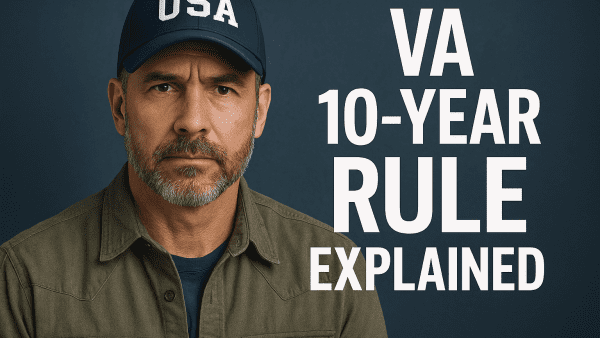Looking for Expert-Level VA Claim Answers?📱Call Us Now! 737-295-2226
Navigating the VA disability claims process can be complex, especially when it comes to understanding the standards of proof required to establish service connection for a disability.
A fundamental concept in this process is the “at least as likely as not” standard, which the VA uses to determine service connection for disability benefits.
This standard is pivotal in determining the outcome of your VA claim, and a clear grasp of its application can significantly impact a veteran’s ability to secure the benefits they’ve earned.
Table of Contents
Summary of Key Points
- The VA’s “At Least As Likely As Not” Standard Defines Service Connection: The “at least as likely as not” standard means that if there is a 50% or greater probability that a veteran’s disability is related to military service, the VA should grant service connection. This standard is lower than those used in criminal and civil cases and is designed to be veteran-friendly. If the evidence is equally balanced (50/50), the Benefit of the Doubt Rule (38 U.S.C. § 5107(b)) requires the VA to rule in favor of the veteran.
- Medical Nexus Opinions Are Critical in VA Claims: A medical nexus opinion is essential in linking a veteran’s disability to military service. VA Compensation & Pension (C&P) examiners or independent medical professionals must explicitly state whether it is “at least as likely as not” that a condition is service-connected. If a VA examiner issues a negative opinion, veterans should consider obtaining an independent medical opinion (IMO) that properly applies the VA’s standard of proof. Many private doctors are unfamiliar with VA terminology, so educating them on this standard is crucial.
- Veterans Must Be Proactive in Providing Evidence: Veterans should submit all relevant medical records, service documents, and lay statements to strengthen their claims. If a C&P exam results in an unfavorable opinion, veterans have options: they can challenge the results with a new medical opinion, request a new C&P exam, or pursue an appeal through a Higher-Level Review (HLR) or Supplemental Claim. Understanding and applying the “at least as likely as not” standard correctly can significantly impact the success of a VA disability claim.
Understanding Legal Standards of Proof
In different legal contexts, varying standards of proof determine the outcome of cases:
- Criminal Cases: The highest standard, “beyond a reasonable doubt,” is used in criminal trials. This means the prosecution must prove the defendant’s guilt to the extent that no reasonable doubt remains in the mind of a rational person. If any reasonable doubt exists, the defendant must be found not guilty under the law.
- Civil Cases: The standard is “preponderance of the evidence,” meaning the evidence presented by one party is more convincing than the other’s. This requires proving a claim is more likely true than not—just over 50% probability (also known as “more likely than not”). This standard applies in personal injury claims, contract disputes, and other civil litigation.
- VA Disability Claims: The standard is “at least as likely as not,” meaning there is a 50% or greater probability that a veteran’s condition is related to military service. If the evidence is equally balanced (50% for and 50% against), the Benefit of the Doubt Rule (38 U.S.C. § 5107(b)) requires the VA to rule in favor of the veteran. This reflects the VA’s non-adversarial, veteran-friendly approach to disability compensation.
What is the VA’s “At Least As Likely As Not” Standard?
In the context of VA disability claims, the standard of proof is “at least as likely as not.”
This translates to a 50% or greater probability that a veteran’s disability is connected to their military service.
If the evidence supporting service connection is equal to or outweighs the evidence against it, the benefit of the doubt goes to the veteran (just like in baseball, the tie goes to the runner).
This principle is rooted in the VA’s commitment to administering the law under a broad and liberal interpretation, consistent with the facts of each case.
Application in Medical Opinions for VA Disability
A critical component of establishing service connection is the medical nexus opinion, which links a veteran’s current disability to their military service.
During Compensation and Pension (C&P) examinations, VA medical examiners assess whether it is “at least as likely as not” that a veteran’s condition is related to service.
An unfavorable opinion might state, “It is less likely than not that the veteran’s condition is due to their in-service injury or event,” indicating a less than 50% likelihood of a service connection.
Veterans have the option to seek independent medical opinions (IMOs) to support their claims.
When obtaining such opinions, it’s crucial to ensure that the medical professional uses the specific language of “at least as likely as not.”
Many private healthcare providers may not be familiar with VA terminology, so educating them on this standard is essential.
A well-supported, favorable nexus opinion using the correct standard can effectively counter a negative C&P examination and strengthen the evidence for service connection.
The Benefit of the Doubt Doctrine
The “at least as likely as not” standard aligns with the VA’s “benefit of the doubt” doctrine.
According to 38 U.S.C. § 5107(b), when there is an approximate balance of positive and negative evidence regarding any issue material to the determination of a matter, the VA shall give the benefit of the doubt to the claimant.
This means that if the evidence for and against a claim is in equipoise, the decision should favor the veteran.
Practical Implications for Veterans
Understanding and effectively applying the “at least as likely as not” standard can significantly influence the success of a VA disability claim.
Veterans should:
- Gather Comprehensive Evidence: Submit all relevant medical records, service documents, and lay statements that support your VA claim.
- Obtain a Strong Nexus Letter: Ensure that any independent medical opinion explicitly states that the condition is “at least as likely as not” related to military service.
- Be Proactive: If a VA-provided C&P examination results in an unfavorable VA medical opinion, consider seeking an independent medical evaluation to provide additional evidence. You can also request a new C&P exam or begin the appeals process with a Higher-Level Review (HLR) or Supplemental Claim.
Conclusion & Wrap-Up
The “at least as likely as not” standard is a cornerstone of the VA disability claims process, reflecting the agency’s commitment to a veteran-friendly adjudication system.
By understanding this standard and ensuring that evidence meets this threshold, veterans can enhance their chances of securing the benefits they deserve.
Remember, in the VA system, when the evidence is evenly balanced, the tie goes to the veteran.
About the Author

Brian Reese
Brian Reese is a world-renowned VA disability benefits expert and the #1 bestselling author of VA Claim Secrets and You Deserve It. Motivated by his own frustration with the VA claim process, Brian founded VA Claims Insider to help disabled veterans secure their VA disability compensation faster, regardless of their past struggles with the VA. Since 2013, he has positively impacted the lives of over 10 million military, veterans, and their families.
A former active-duty Air Force officer, Brian has extensive experience leading diverse teams in challenging international environments, including a combat tour in Afghanistan in 2011 supporting Operation ENDURING FREEDOM.
Brian is a Distinguished Graduate of Management from the United States Air Force Academy and earned his MBA from Oklahoma State University’s Spears School of Business, where he was a National Honor Scholar, ranking in the top 1% of his class.



